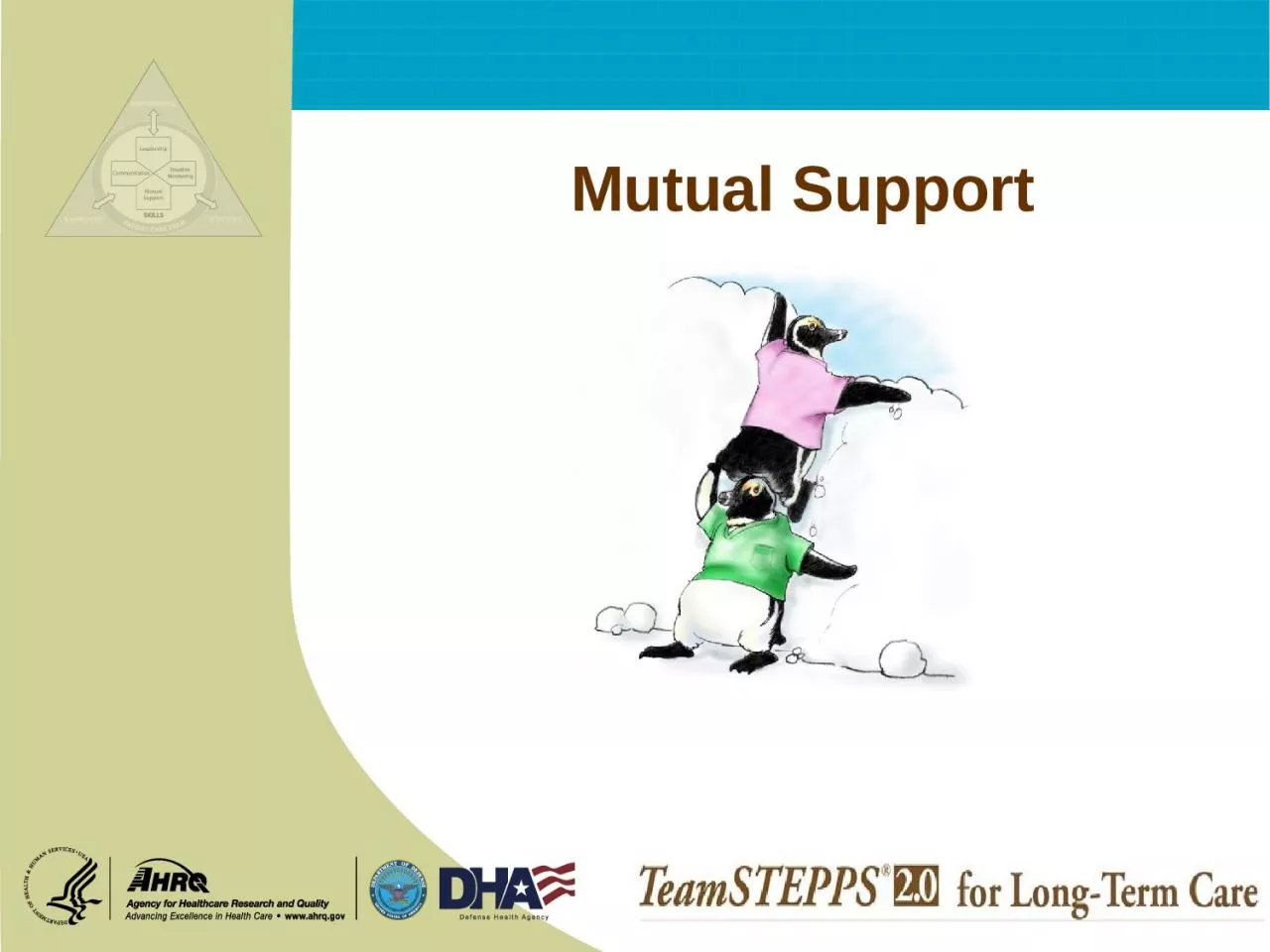

Describe how mutual support affects team processes and outcomes Discuss specific strategies to foster mutual support eg task assistance feedback Identify specific tools to facilitate mutual ID: 1010016
Download Presentation The PPT/PDF document "Mutual Support Objectives" is the property of its rightful owner. Permission is granted to download and print the materials on this web site for personal, non-commercial use only, and to display it on your personal computer provided you do not modify the materials and that you retain all copyright notices contained in the materials. By downloading content from our website, you accept the terms of this agreement.
1. Mutual Support
2. ObjectivesDescribe how mutual support affects team processes and outcomesDiscuss specific strategies to foster mutual support (e.g., task assistance, feedback)Identify specific tools to facilitate mutual support Describe conflict resolution strategies
3. Mutual SupportDependent upon information gathered through situation monitoringModerated by the communication of informationEnhanced by leaders who encourage and role model mutual support behaviors
4. Mutual support involves members:Assisting each other Providing and receiving feedbackExerting assertive and advocacy behaviors when resident safety is threatenedMutual Support
5. Task AssistanceTeam members foster a climate in which it is expected that assistance will be actively sought and offered as a method for reducing the occurrence of error.
6. Task Assistance ExampleTwo members of the GI Laboratory are assessing a resident who has just had conscious sedation for a colonoscopy. The monitor shows SVT at a rate of 150 and a BP of 76/48. The nurse calls out the vital signs while the physician continues to monitor the rhythm. A nurse passing by the room hears the call-out.
7. What Is Feedback?Feedback is information provided for the purpose of improving team performance
8. Types of FeedbackFormal Retrospective and typically scheduled in advanceHas an evaluative qualityExamples: Collaborative discussions, case conferences, individual performance reviewsInformal Typically in real timeProvided on an ongoing basisFocuses on knowledge and practical skills developmentExamples: Huddles, debriefs
9. Characteristics of Effective Feedback Effective feedback is—TimelyRespectfulSpecificDirected toward improvementHelps prevent the same problem from occurring in the futureConsiderate
10. Providing Effective Feedback Video
11. Feedback ExerciseA staff development nurse watches a nursing assistant use a mechanical lift to transfer a resident from the bed to a chair. The nurse pulls the nursing assistant aside and reminds her of the proper positioning of the lift pad, showing the nursing assistant which landmarks to use. She explains how the resident’s position can affect the function of the lift and that friction and sheer to the resident’s skin can result when the resident is not positioned properly. How would you provide effective feedback?
12. Advocacy and AssertionAdvocate for the resident:Used when team members’ viewpoints don’t agree with that of a decisionmakerAssert a corrective action in a firm and respectful manner
13. The Assertive StatementRespectful and supportive of authorityClearly asserts concerns and suggestionsIs nonthreatening and ensures that critical information is addressedFive-Step Process:Open the discussionState the concernState the problem—real or perceivedOffer a solutionObtain an agreement
14. Two-Challenge Rule 12
15. Two-Challenge RuleInvoked when an initial assertion is ignored…It is your responsibility to assertively voice your concern at least two times to ensure that it has been heardThe member being challenged must acknowledgeIf the outcome is still not acceptableTake a stronger course of action Use supervisor or chain of command
16. Two-Challenge Rule cont.Empower any team member to “stop the line” if he or she senses or discovers a breach of safety.This is an action never to be taken lightly, but it requires immediate cessation of the process and resolution of the safety issue.
17. Please Use CUS Wordsbut only when appropriate!
18. Advocacy and Assertion ScenarioA high school senior working in the Dietary Department is wheeling the steam-tray table down the hall after dinner. Ahead of her, she sees a nursing assistant escort a resident into his room and close the door. As she passes the room, she hears a raised voice and believes it to be the nursing assistant. She feels she should knock on the door or tell someone but doesn’t.
19. Conflict in TeamsInformational Conflict(We have different information!)Two-Challenge Rule Interpersonal Conflict(Hostile and harassing behavior)DESC Script
20. Conflict ResolutionDESC Script A constructive approach for managing and resolving conflictD—Describe the specific situation E—Express your concerns about the actionS—Suggest other alternativesC—Consequences should be stated
21. DESC-ItHave timely discussionWork on win-winFrame problem in terms of your own experienceChoose a private locationUse “I” statements; avoid blaming statementsCritique is not criticismFocus on what is right, not who is rightLet’s “DESC-It!”
22. A DESC Scenario Two days ago, the charge nurse submitted a maintenance request to fix a window unit air conditioner. While in the resident’s room, the nurse realizes it is warm and the air conditioner still isn’t working properly. She checks the logbook and sees that the maintenance request has not been completed. She doesn’t know that a new unit is being delivered today. Worried about the comfort of her resident, who has difficulty breathing in warm weather, she raises her voice at the director of maintenance in front of staff and residents, criticizing his work ethic.
23. Tools & Strategies SummaryBARRIERSInconsistency in Team MembershipLack of TimeLack of Information SharingHierarchyDefensivenessConventional ThinkingComplacencyVarying Communication StylesConflictLack of Coordination and Followup With CoworkersDistractionsFatigueWorkloadMisinterpretation of CuesLack of Role ClarityTOOLS and STRATEGIESCommunicationSBARCall-OutCheck-BackHandoffLeading TeamsBriefHuddle DebriefSituation MonitoringSTEPI’M SAFEMutual SupportTask AssistanceFeedbackAssertive StatementTwo-Challenge RuleCUSDESC ScriptOUTCOMESShared Mental ModelAdaptabilityTeam OrientationMutual TrustTeam PerformanceResident Safety!!
24. Applying TeamSTEPPS ExerciseIs your teamwork issue related to mutual support?If yes, what is the mutual support issue?Which mutual support tools or strategies might you consider implementing to address the issue?